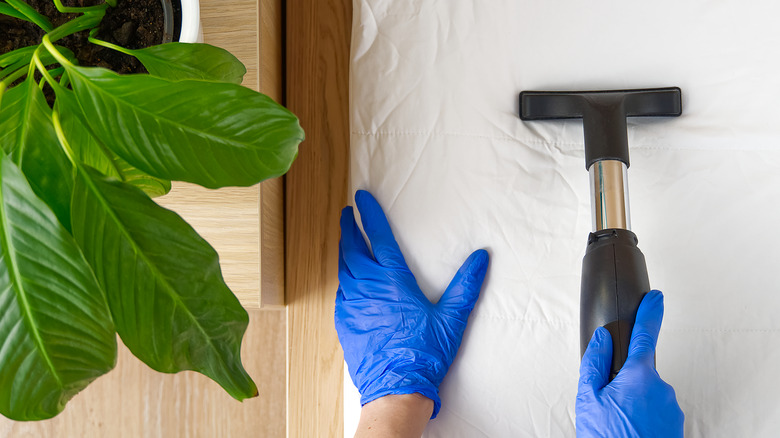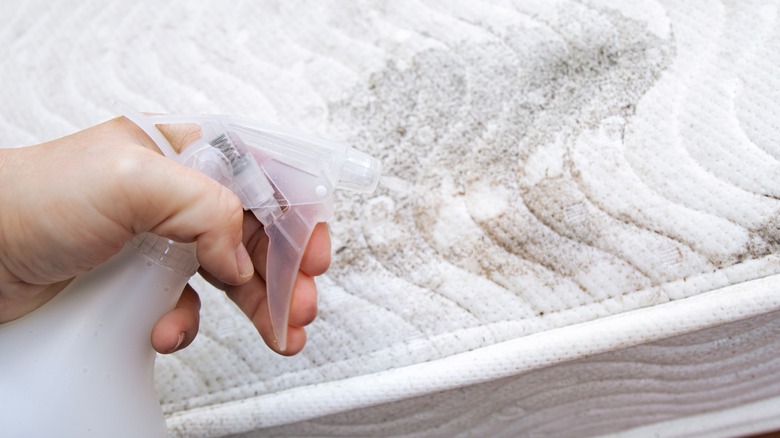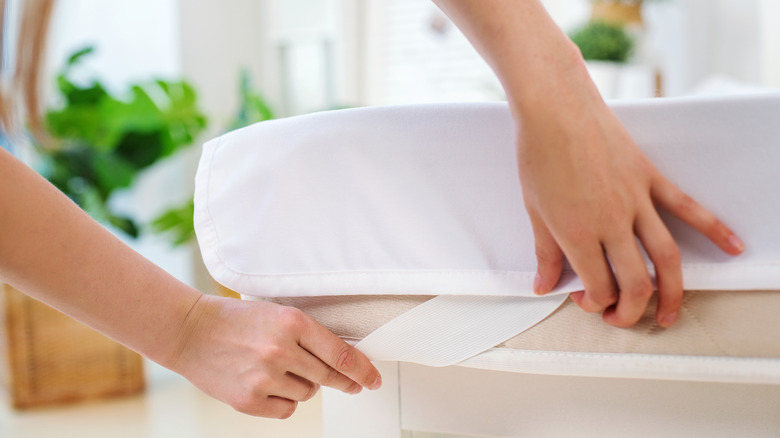Say Goodbye To Mold On Your Mattress With This Trick
Learning you have mold on your mattress can be quite worrisome, and it may make you want to head out to buy a new one. Before you do, it's possible to clean the mold off a mattress in many situations, especially if it hasn't been there long or isn't saturated in the material. To clean mold from a mattress, you'll need to start cleaning loose debris and then killing the mold itself. After doing that, it helps to sanitize the surface of the mattress before ensuring it dries fully. The key to getting rid of mold is being thorough, but you cannot saturate the mattress or pour chemicals onto it that could damage the fabric.
If you see signs of mold on your mattress, such as the development of dark spots and blotches that discolor it or the presence of musty odors, it's time to get to work. However, if you are having respiratory symptoms from it, such as coughing or trouble breathing, the mold problem may be too significant to simply clean up. At this point, it may be best to remove the mattress from the home to dispose of it and call a professional to test if there's mold in other areas of the house. You may need mold remediation to ensure all mold spores, including those that may have traveled through your HVAC system, are removed from the home. For most people, though, these steps to cleaning mold from a mattress should work.
Cleaning the mattress of mold
Be sure to wear protective gear for this project to minimize the risk of breathing in mold spores. After removing all of the bedding from the mattress to launder thoroughly, you'll need to try to remove all loose debris from the surface carefully. Use a strong, small vacuum to pull up all loose debris. Remember that the goal here is not to send mold spores into the area, so keep the vacuum as close to the surface of the mattress as possible. Clean as much as possible like this. Then, be sure to empty the vacuum directly into the trash outside the home.
To treat the mold still present, use a solution of isopropyl alcohol and water in a 1:1 ratio. This will clean the mold on the surface of the mattress as you gently apply it either in a spray bottle or with a cloth. Don't rub it in, but simply blot the surface. Then, use another towel and clean water to rinse this. You may need to repeat this process, working small sections of the mattress at a time. Keep the amount of water used minimally to avoid it soaking into the mattress.
Use a sanitizing solution purchased at most home improvement stores as the next step. These specific fabric sanitizers may work to kill any existing microbes that could encourage further mold growth. Look for those that specifically target mold prevention.
Dry and protect the mattress from mold
After you've cleaned the mattress fully, it's time to dry it out. Mold thrives in moist environments, so you want to use a fan or place the mattress in direct sunlight. Use a dehumidifier, too. Ensure that the mattress dries fully before you cover it or use it.
Then clean the surrounding area using an antibacterial cleaning solution for the foundation of the bed, headboard, nightstand, and anything else in the general area. It's a good idea to sanitize all surfaces in the room where the mattress was, including cleaning the carpet since mold spores can easily spread this way. Ensure that, on high humidity days, you run the air conditioner or a dehumidifier to prevent mold development as well.
After it dries, there are a few simple steps you can take to prevent mold regrowth. First, keep liquids out of your bed (especially anything but water which may contribute to feeding mold spores). Use a waterproof covering over the top of the mattress, followed by a fitted sheet. This helps minimize the amount of debris that gets into the mattress, including dust, dander, human skin cells, and other microbes that are also sources of food for mold spores. By properly cleaning your mattress and minimizing any moisture buildup within it, you're avoiding some of the most common mistakes that ruin mattresses. You're also working to protect your health from mold spores.


